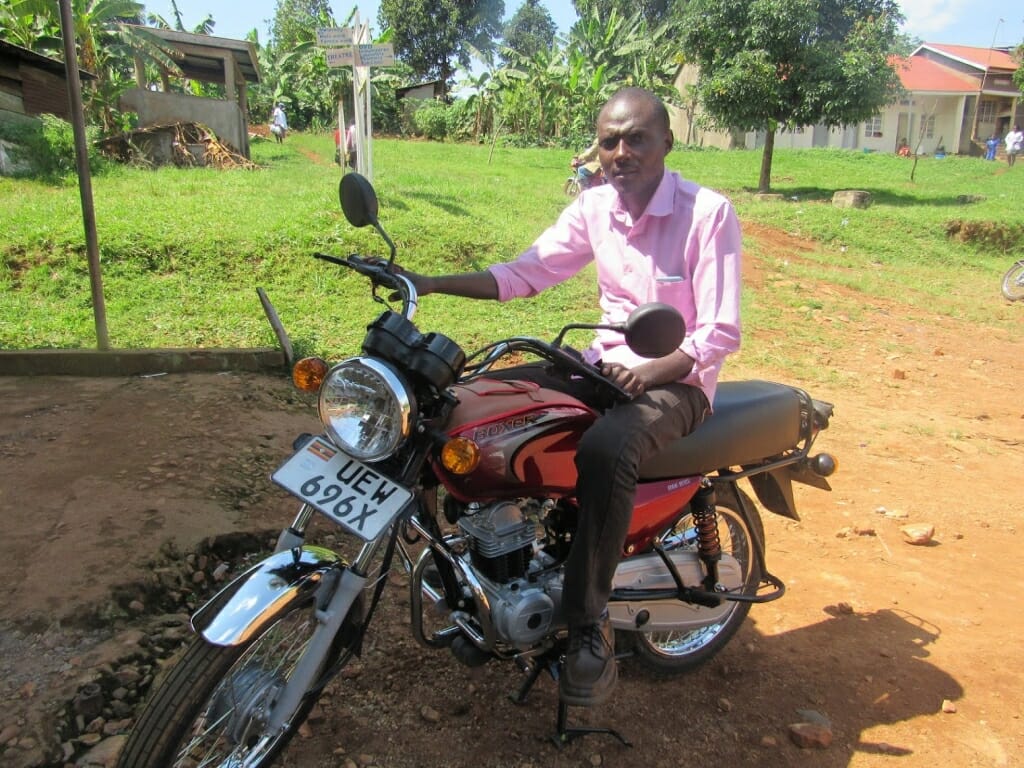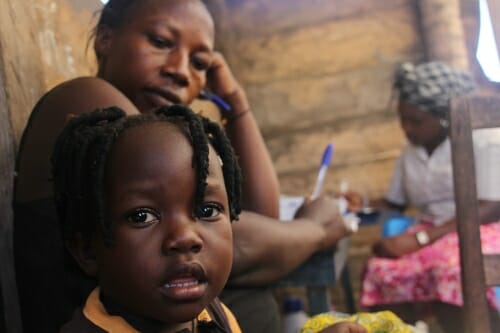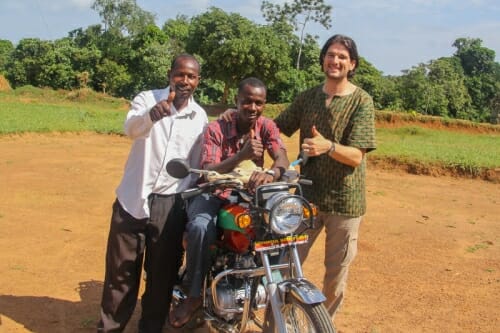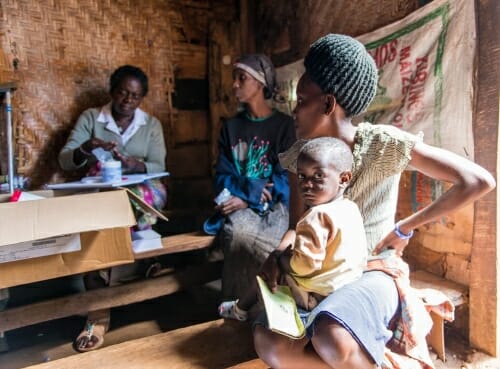Using motorcycles and 55-cent payments, Uganda groups maps route to health care in remote villages

Moses Tindyebwa, with the new motorcycle he bought with a loan from a Uganda non-profit that merges microfinance and health care accessibility. Photo by Kevin Gibbons
KAMPALA, Uganda – A nonprofit group in Uganda has issued another loan for a motorcycle-taxi that will also offer free transport for health care workers.
Motorcycle taxis are the common form of transportation in rural Uganda, and the recipient, Moses Tindyebwa, has already begun driving for hire.
But for three days a month, he will ferry health care workers to remote Ugandan villages on Bugala Island in Lake Victoria. These short but essential trips, organized by Health Access Connect (HAC), deliver government health workers to villages that, with HAC’s help, now have a health facility.

Community health worker Annet Namwanje and her daughter outside an outreach clinic in Senero village, Kalangala District, Uganda. Community health workers are village residents with some basic health training. Photo by Kevin GIbbons
By helping organize monthly clinics and lending to motorcycle buyers who are obligated for 18 months to transport health care workers, HAC “bridges the last few miles,” says Kevin Gibbons, 37, who received a master of science in conservation biology and sustainable development at University of Wisconsin–Madison in 2012.
After 18 months, assuming that Mr. Tindyebwa pays the loan as six of his predecessors have done, he will own the motorcycle. If he then he continues driving health workers, he will be paid.
HAC and its peculiar hybrid model of microfinance and healthcare delivery are the brainchild of Gibbons and Carolyne Ariokot, a Ugandan citizen who works at KCB Bank in Kampala.
The roots of the idea were planted during Gibbons’s graduate work at UW–Madison’s Nelson Institute for Environmental Studies. In 2008, Gibbons studied fisheries governance in Lake Victoria fishing communities.

Kevin Gibbons, HAC staffer Miiro Deo, and motorcycle taxi driver and loan recipient Mike Nsubuga pose with the first HAC motorcycle that was purchased with a loan to Nsubuga. Photo by Jimmy Kizibwe
“I was asking questions about environmental governance, migration, and whether people had enough to eat, and my interviewees would tell me, ‘You come here and build a hospital,’ and they could point to their neighbors’ houses and tell me so-and-so died of HIV three weeks ago, and this person died two months ago. I thought, ‘But healthcare is just three miles away! There’s got to be a way to fix this problem.’”
Access to trained health workers and medicine is free in Uganda.
HAC’s unusual marriage of microfinance and health care has flourished since it opened in Uganda in 2014. During 2018, the motorcycles it financed delivered health care workers to clinics in more than 30 villages, where they served more than 5,000 patients.
The patients come for routine checkups, perinatal and child care, family planning, vaccinations, and treatments for HIV/AIDS, malaria and sexually transmitted diseases.
Gibbons maintains strong relations with UW–Madison. “We’ve had seven interns from UW–Madison, working on communications, data collection, grant proposals,” he says.
In summer, 2018, Vansh Jain, now a junior majoring in biochemistry and international studies, spent two months in Uganda, evaluating data collection and improving report forms for health care workers.

A woman and her daughter wait at an outreach clinic in Uganda. Their medical worker reached the monthly clinic on a motorcycle, as part of a project by Health Access Connect. Photo by Ella Guo
“I always wanted to combine my passions for international studies with medicine,” Jain adds, “but this was my first real experience working in health care abroad. It broadened my horizons and opened a path for a future career in the global health setting.”
While crafting its novel approach to the persistent shortage of rural health care, HAC stumbled on a key to a larger issue – the unsustainability of health care nonprofits.
Typically, nonprofit health care projects are supported by three-year grants. When the grant expires, so does the health care.
“On a typical medical mission, doctors and nurses can spend a lot of money and treat a lot of people, but with us, every month, the village is going to see health workers,” Gibbons says.
“People in aid agencies are interested that we were able to get the patient to pay 55 cents to cover the transport,” Gibbons says. “This speaks to a model that is more sustainable,” although he concedes that he, like co-founder Carolyne Ariokot, have yet to earn a paycheck.
“The fact that we have been able to convince patients to pay a small amount for transport opens a lot of doors in ensuring access,” Gibbons says.
Recognizing HAC’s scalable, sustainable model of health care delivery, Gibbons was recently awarded one of 10 Global Good Fund 2019 Fellowships.
HAC has five full-time Ugandan staff members, in addition to Gibbons and Ariokot.
Each outreach clinic is overseen by a local community health worker, Gibbons says, to ensure sustainability and avoid being seen as elite outsiders with all the answers.
More than four years after starting HAC, Gibbons says, “What I did not anticipate was that an idea is only as good as its execution … and its funding. What inspired me was the mission. I am a Returned Peace Corps Volunteer, now I am the lead money person. I track down money so the salaries get paid. I find donors, get the organization noticed and submit grant proposals.”
Transportation assisted by microfinance has made a difference, Gibbons says. “We’ve helped serve about 13,000 patients, and all this is happening because we are erasing the three miles, five miles, eight miles that separate people in a village from the nearest health care. That’s a lot if you can’t afford to pay for transport. Bringing the health care worker to the village reduces the cost of delivering health care.”
Tags: alumni, health care, international
